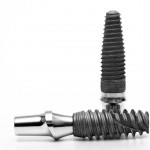
Dental implants are increasing seen as an effective restorative option with survival rate over 90% in the long term. While case selection is important implant design is also considered to have an impact on survival and manufacturers have claimed that microthreads in the crestal portion can reduce marginal bone loss (MBL) around implants.
The aim of this review was to investigate the marginal bone loss around dental implants with and without microthreads in the neck.
Methods
Searches were conducted in the Medline/PubMed, Cochrane Central Register of Controlled Trials (CENTRAL), Embase, Web of Science and AMED databases. These were supplemented by hand searches in the journals; Clinical Implant Dentistry and Related Research, Clinical Oral Implants Research, European Journal of Oral Implantology, Implant Dentistry, International Journal of Oral and Maxillofacial Surgery, Journal of Cranio-Maxillofacial Surgery, Journal of Dental Research, Journal of Oral Implantology, and Journal of Periodontology.
Randomised clinical trials (RCTs) that compared the MBL between implants with and without microthreads in the neck were considered. Two reviewers independently conducted the search, selected studies, abstracted data and assess the study quality. The Cochrane risk of bias tool was used to assess study quality. marginal bone loss (MBL) was assessed using mean differences (MD).
Results
- 5 studies involving a total of 339 implants were included.
- 3 studies (75 implants) contributed to a meta-analysis. MD= -0.09 (95%Cl; −0.18 to −0.01). This means that MBL was significantly less in roughened implants with microthreads than without microthreads.
Conclusions
The authors concluded:-
Meta-analysis showed that microthread design in the implant neck can reduce the amount of MBL; however, RCTs included in the review were few and the difference was small. In clinical practice, an implant with a roughened surface and microthreaded neck could be selected to maintain bone level.
Comments
Several major databases were searched for this review and only randomised controlled trials were included. Unfortunately, only a small number of studies were available with only 3 contributing to the meta-analysis. As noted by the authors the follow up period for the studies was short with 3 of the 5 studies only having 1 year of follow up. The limited follow up period means that one of the two primary outcomes indicated in the online protocol implant failures was not addressed. While the review does indicate that there was significantly less MBL in the roughened implants with microthreads the clinical importance of this is less obvious so the call by the authors for more high quality RCTs with larger sample sizes and longer follow up times is appropriate.
Links
Primary paper
Niu W, Wang P, Zhu S, Liu Z, Ji P. Marginal bone loss around dental implants with and without microthreads in the neck: A systematic review and meta-analysis. J Prosthet Dent. 2016 Sep 16. pii: S0022-3913(16)30217-7. doi: 10.1016/j.prosdent.2016.07.003. [Epub ahead of print] Review. PubMed PMID: 27646798.
Other references
Original review protocol on PROSPERO
